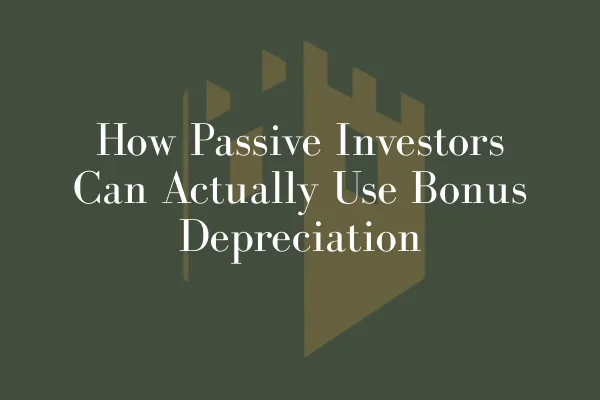
How Passive Investors Can Actually Use Bonus Depreciation
How Passive Investors Can Actually Use Bonus Depreciation
Bonus depreciation is back—and it’s permanent. If you’ve been in the real estate investing space for more than five minutes, you’ve probably heard about this as the ultimate tax strategy.
But here’s the truth: most passive investors can’t use it the way they think.
Unless you know how the IRS defines “passive,” you might get excited about a $30,000 paper loss… and then realize it won’t reduce your actual tax bill.
Let’s clear that up right now.
The Promise of Bonus Depreciation
Under the OBBBA, 100% bonus depreciation is now permanent for qualifying assets. That means when you invest in a deal that buys real estate and performs a cost segregation study, 20–30% of the purchase price can be written off in year one.
If you put $100K into a syndication, your K-1 might show a $25K to $35K loss in the first year. But the key question is: can you use it?
The Catch: Passive Loss Limitations
Under IRS rules, passive losses can only offset passive income—not your W-2, not your business income, not your crypto gains.
And most investors in syndications or funds are treated as passive under Section 469.
So unless you qualify as a real estate professional or meet one of the exceptions, you’ll likely be limited in how much of that loss you can actually use.
What Qualifies as Passive Income?
You can offset depreciation losses against:
Rental income from other real estate
Passive income from certain private funds (not interest income)
Gain from the sale of passive assets
You cannot offset:
W-2 income
Active business income
Interest or dividend income
Capital gains from stock or crypto (unless the asset is considered passive)
Option 1: Real Estate Professional Status (RE Pro)
This is the gold standard. If you or your spouse materially participate in real estate and spend 750+ hours in a real estate trade or business, you can be classified as a real estate professional.
That unlocks the door to using real estate losses to offset other income types.
Important: If you’re married and filing jointly, only one spouse needs to qualify to unlock the benefit. I’ve seen clients structure this brilliantly—with one spouse managing a short-term rental portfolio, freeing the other to stay focused on their W-2.
Option 2: Short-Term Rentals (STRs)
Short-term rentals are a powerful workaround. Here’s why:
The IRS doesn’t treat STRs as traditional rentals under Section 469
If you materially participate in your STR (manage bookings, guests, repairs, etc.), you may be able to claim those losses as active, even if you’re not a real estate professional
This is one of the most underutilized strategies I see—and one we help clients implement properly.
Option 3: Grouping Elections
In some cases, you may be able to make a grouping election to combine your passive and active businesses. This is complex and must be carefully documented, but for certain taxpayers, it opens the door to more flexible tax treatment.
What Passive Investors Should Actually Do
Talk to your CPA before you invest
Don’t assume a deal’s “depreciation benefits” apply to you. Have your advisor run projections under your tax profile.Understand your participation status
Are you active, passive, or a real estate professional? If you don’t know, your CPA might not either.Use STRs as a strategic wedge
We’ve helped clients buy one or two STRs, qualify as active, and unlock five- to six-figure write-offs.Build your portfolio with purpose
Mixing passive income (from lending funds, for example) with depreciation-heavy investments can create balanced, tax-optimized returns.
Final Thought
I see too many investors throw bonus depreciation into their pitch decks without understanding how it actually works. That’s not strategy—that’s marketing.
If you’re serious about using tax strategy to grow wealth, you need more than a line on a K-1. You need structure, planning, and a CPA who’s walked through it personally.
